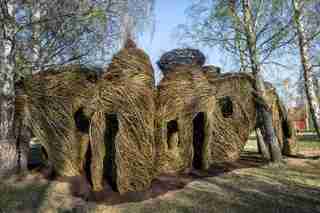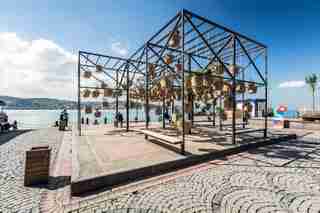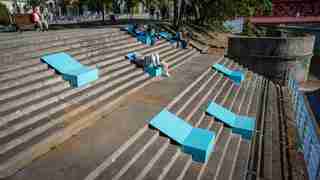Even the most exciting cities have public spaces that aren’t being used to their fullest potential. Sometimes a lack of funding or uncertainty of what to do with unused space makes it difficult to breathe life into an area again, but many regions have found that partnering with up-and-coming design talents is a surefire method of drawing attention to neglected spaces. Outdoor architectural installations are a major draw for tourists as well as for locals, because they bring something new and unexpected to a familiar location. They are generally free to view (or inexpensive) and have the power to attract and inspire audiences of all kinds—children and design experts alike. From eco-sculptures in Sweden to temporary playgrounds in Atlanta , these six architectural installations are designed to reimagine their environments.

Patrick Dougherty’s Lucky Seven in Vimmerby, Sweden
Inspired by the Pippi Longstocking children’s books, Patrick Dougherty’s Lucky Seven is a fantastical version of the messages in a bottle Pippi would send. The jar-like structures are made entirely of willow and witch hazel and were designed for children to play in and in which to experience a moment of magic. Dougherty has been creating environmental structures and architectural installations for over 30 years, with 250 works all around the world. His pieces generally stand for about two years, so Lucky Seven is expected to be on display until spring of 2018.

SO? Studio’s Sky Garden in Istanbul
Ortaköy Square , a congested tourist destination in Istanbul, recently introduced an interactive “Sky Garden.” A traditional garden would have complicated the already busy area, but the design by Istanbul-based SO? Studio uses a hanging garden as a canopy over some additional seating space. The plants are hooked up to a simple pulley system that allows visitors to pull down a pot for a closer look, raising a counterbalancing pot somewhere else on the structure. By giving the audience autonomy, the design studio said they were looking to create a complicated relationship, with the idea of control, even in small-scale environments like an art installation. It will be up until the end of June. It will be up until the end of June.

No Studio’s Micro-installations in Wrocław, Poland
Part of No Studio ’s design mantra is, “We try to solve problems rather than create monuments.” The Polish design duo, made up of Magda Szwajcowska and Michal Majewski, focus on intervening when urban public spaces are neglected, using temporary architecture and micro-installations. The space for their most recent project is a set of stairs leading to the River Oder that rarely sees much foot traffic. For the 2016 local architecture festival DoFa , their simple but effective solution was to add vibrant sunbathing half-chairs that make the space more attractive and user-friendly. Not only was the project a much easier undertaking than a larger installation, but it was also low in cost—a lesson to their city in affordable urban planning. Due to the community’s love for them, the installations will remain up for the time being.
Studio Makkink & Bey’s Uproot Rotterdam in Rotterdam, Netherlands
A pop-up sculpture park opened at the Museum Boijmans Van Beuningen in Rotterdam as a tribute to the city’s post-World War II history into modern times. Studio Makkink & Bey was commissioned to transport some of the city’s most recognized sculptures to this destination, and line them up chronologically starting in 1940, after the Rotterdam Blitz. This temporary installation is intended to symbolize the city’s constant evolution. It will be open until August 21.
Jaime Hayon’s Tiovivo in Atlanta
The High Museum of Art in Atlanta hosts temporary installations several times a year to bring art and culture to the Carroll Slater Sifly Piazza. Spanish designer and artist Jaime Hayon ’s recent contribution is a set of oversize wood children’s toys. The four structures feature exciting patterns and colors, with slides and ladders to welcome playful children. Transforming the outdoor space into a larger-than-life playground, Tiovivo will be exhibited until November 27.
Olafur Eliasson’s Vær i Vejret in Charlottenlund, Denmark
Danish-Icelandic artist Olafur Eliasson was inspired by the local climate when creating his interactive installation (whose name translates as “weather of weather) at the Ordrupgaard Museum Park . The piece briefly makes the wind visible by using a ring that produces fog every time it changes direction. When visitors stand in the middle of the ring, they become surrounded by the dreamy mist. The artist made a statement saying, “Works of art that are displayed outdoors are inevitably exposed to the elements, so whether we like it or not, the weather will always be a part of the work.”
